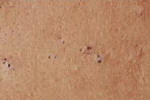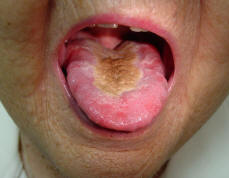Oily skin
Oily skin is shiny, thick and dull colored. Often a chronically oily skin has coarse pores and pimples and other embarrassing blemishes. It is prone to blackheads. In this type of skin, the oil producing sebaceous glands are overactive and produce more oil than is needed. The oil oozes and gives the skin a greasy shine. The pores are enlarged and the skin has a coarse look.
-
Heredity
- Diet
- Hormone levels
- Pregnancy
- Birth control pills
- Cosmetics you use
- Humidity and hot weather
Because of the hormonal shifts of adolescence, oily skin is common in teenagers, but it can occur at any age. In general, skin tends to become dryer with age. The flow of sebum or oil increases during adolescence and starts decreasing with age. During pregnancy and menopause, hormonal imbalances can also upset the oil balance and increase the activity of sebaceous glands.
Many people have skin that is oily only in certain areas and dry or normal in others, a condition known as combination skin.
The great advantage of oily skin is that it ages at a slower rate than other skin types.
Oily skin needs special cleansing with plenty of hot water and soap to prevent the pores from being clogged. Avoid harsh products that strip your skin of oil and encourage flakiness. They can cause a reaction known as reactive seborrhoea, where the oil glands work overtime to compensate for the loss of natural oils.
Avoid skincare products that leave your skin feeling taut and dehydrated. They cause the upper layers of the skin to shrink. This restricts oil flow through the pores leading to blockages and breakouts.
To cleanse oily skin, use oil-based products as they dissolve sebum effectively. Opt for oil-free moisturizers to maintain a shine-free complexion.
Keep your skin very clean. Limit washing your face to two or three times a day. Too much washing will stimulate your skin to produce more oil.
Choose your cleanser with care. Avoid heavy cleansing creams. Avoid the use of harsh soaps or cleansers. Use a pure soap with no artificial additives. Try an antibacterial cleansing lotion or a lightly medicated soap, and use it in combination with a water rich in minerals, not tap water. Do not use cleansers or lotions that contain alcohol. After cleansing, apply a natural oil-free moisturizer to keep the skin supple.
Use hot water when washing your face. Hot water dissolves skin oil better than lukewarm or cold water.
If your skin is extremely oily, three or four daily cleansings may be in order and little or no moisturizing necessary before you are 30 years old. After that point, the skin around your eyes and mouth and on your throat may benefit from a nightly moisturizing, plus a mere touch of moisturizer in the morning.
When cleansing, massage your face well with your fingertips, using an upward and outward motion. Be careful not to rub soap into the skin; it can clog pores.
If your oily skin is scaly, you can often correct the problem by using a deep-cleaning exfoliant on alternate nights, and following the treatment with a light coating of moisturizer.
Try using a clay or mud mask. If you have sensitive skin, use white or rose-colored clays.
Use a light antiseptic night cream from time to time if you wish, and apply a clarifying mask one or two times a week.
Choose cosmetic and facial care products specifically designed for oily skin.
Before applying makeup, use an antiseptic day cream with active ingredients that diminish sebaceous secretions. Look for benzyl peroxide in the list of active ingredients.
Use a light antiseptic night cream from time to time if you wish, and apply a clarifying mask one or two times a week.





















































